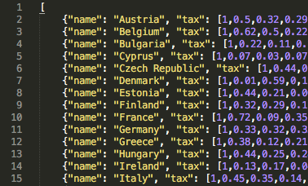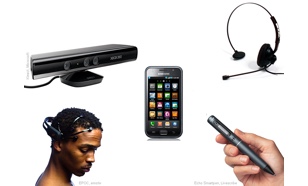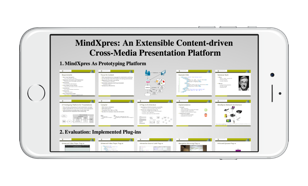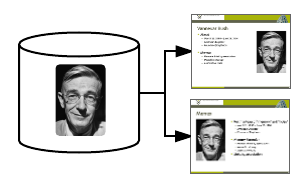Content Reuse
Current presentation tools often store presentations in monolithic self-contained files but this makes it harder to reuse or share smaller parts of content.
When reusing content users often copy-paste certain slides and create multiple presentations with duplicate content.
However, when an update is required the presenter would have to update the content in multiple presentations which is of course undesirable.
MindXpres approaches this issue by storing a user's content in a single database. All content (e.g. text, images or bullets) are stored separately and can easily be reused in other presentations. This means that content is not only reusable on the slide level but at any granularity. If desired, the reused content remains linked to the original so that both are updated when one changes. Selected content from your personal database could also be shared with selected users so that they may use an always up to date version of your content in their presentations.
Currently the possibility to semantically annotate content and links is being investigated.
For instance, content might be (semi-)automatically annotated to indicate that it belongs to a certain topic or concept.
Then, during a presentation the presenter would be able to navigate to related content on demand even if it was not part of that particular presentation.
Furthermore, it opens doors for (semi-)automatically generating presentations for a given topic, or for providing suggestions during the authoring of a new presentation.
Feature Overview

In MindXpres everything is a plug-in. From the way content is visualised and navigated all the way down to basic components such as images or text, anything can be configured or even replaced.

The plug-in mechanism allows presenters to choose the presentation visualisation style that suits their content and use case. This includes classic slide sequences, zoomable user interfaces as known from Prezi or other innovative visualisation.

Long gone are the days of static slides with bullet lists and images only. MindXpres plug-ins might provide rich media visualisations reacting to the presenter's or even the audience's input.

MindXpres allows you to focus on the content instead of spending time on styling and layout. Pick a theme, provide the content and let MindXpres worry about the visualisation.

Presentations can also be authored via a declarative language that functions similar to LaTeX. However, in contrast to LaTeX the language can be used to define more dynamic and interactive presentations with access to all MindXpres features and functionality.

Instances of a MindXpres presentation can connect to each other which, for instance, allows audience members to have a mirrored view of what is shown by the presenter on their devices. Other use cases include audience-driven activities such as voting or crowd-sourced note taking.

Regardless of the chosen visualisation style, the user decides in which order content is presented, either by predefining a path or by using one of the many interfaces to efficiently navigate the content in real-time.

MindXpres presentations can not only connect to each other but all kinds of hardware can be integrated in the network for navigation, interaction or audience participation. Examples include customised presenter interfaces running on a mobile device, clickers for audience input or specialised hardware for gesture or voice recognition.

MindXpres generates presentations based on web technologies allowing them to run offline or online, on both computers and mobile devices without the need to install any software. Furthermore, presentations can easily be put online and viewers can replay the presentation as it was given, or explore the presentation by themselves.

Instead of storing presentations in separate presentation files, MindXpres stores all user content in a central repository. This makes it easier to reuse and share content at any granularity, and also allows users to keep content that is part of multiple presentations synchronised and up to date.











